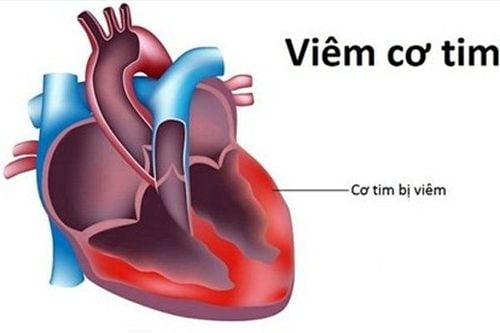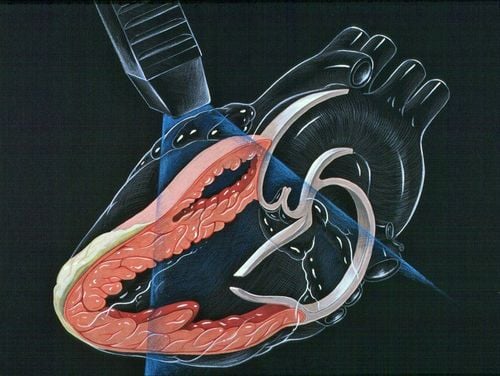This is an automatically translated article.
The article is professionally consulted by Associate Professor, Doctor, Doctor Huynh Thoai Loan - Head of Pediatrics - Neonatology Department - Pediatric Endocrinology Clinic - Vinmec Central Park International General Hospital - Pediatrics Department - Newborn, Vinmec Central Park International General Hospital.Myocarditis is a dangerous acute disease caused by many different causes. Viral myocarditis is the most common causative agent, accounting for over 50% of all cases. The clinical setting of the disease is similar to that of a common viral infection, so it is easy to confuse and miss.
1. What is myocarditis?
Myocarditis is a dangerous disease in which myocardial tissue is damaged by an inflammatory process, with or without involvement of the heart valves and the pericardium. Although the disease is not uncommon in clinical practice, the mortality rate is quite high, especially in cases of myocarditis in children.
Patients with myocarditis die from complications of the disease such as arrhythmia, acute heart failure or cerebrovascular accident, myocardial infarction due to a blood clot blocking the blood vessels.
The cause of this condition is that the disease is often detected at a late stage and missed or misdiagnosed with other diseases with similar symptoms. Myocarditis can appear at any age, but is most common in young people between the ages of 20 and 40. The disease appears sporadically at times of the year, sometimes breaking into epidemics. Thinking of myocarditis in the context of suspected viral infection with cardiovascular symptoms is a measure to help reduce mortality due to untimely treatment.

2. Is myocarditis in children dangerous?
Although children are not the most susceptible to myocarditis in clinical practice, myocarditis in children is considered a serious disease with high mortality. Children with myocarditis have diverse clinical manifestations of myocarditis, the disease progression from mild to severe, rapid and unpredictable. Usually, children will experience symptoms suggestive of an acute viral infection such as high fever, fatigue, headache, etc. This feature becomes a trap that makes parents subjective not to bring their children. My brother went to the doctor and treated promptly.
Children with myocarditis often only have access to medical facilities when the disease has entered a late stage with many life-threatening complications. The average mortality rate of myocarditis in children is over 70%. Many severe cases with severely impaired cardiac function without a heart transplant have a mortality rate of about 50% after two years, increasing to 80% after five years.
3. Virus that causes myocarditis
Virus is considered to be the causative agent of myocarditis with the highest clinical rate according to many statistics. Myocarditis viruses are commonly found in the group of Adenovirus and Enterovirus such as Coxsakie virus group B, A6 or A14, Parvovirus B19, herpes virus type 6, ...
Adenovirus is a group of viruses that cause influenza or other common upper respiratory tract infections. .
Parvovirus B19 is the causative agent of the “fifth disease” with symptoms of lung and tracheobronchial infections, most common in children aged 6 to 10 years. This group of viruses is transmitted mainly through respiratory secretions from infected children. Symptoms appear about 1 week from the time of infection with the virus and last for about a week. Young children infected with the virus often have a characteristic rash on the cheeks, while in older children the rash can appear on many other places on the body such as the hands and feet. Currently, there is no specific vaccine against Parvovirus B19.
Human herpes virus group 6 is a recently discovered virus group and is usually infected in young children, some cases have been reported in children under 1 month of age. Statistics show that about 20% of cases of children hospitalized with fever are related to human herpes virus group 6. After initial exposure, the virus usually resides in the salivary glands and bone marrow for long periods of time. Clinical manifestations caused by this virus include high fever and erythematous skin rash, which may be associated with both hepatitis and encephalitis.
Enterovirus represented by Coxsackie virus is closely related to childhood myocarditis. Coxsackie A viruses cause hand, foot and mouth disease, while Coxsackie B viruses cause milder flu-like symptoms. Along with myocarditis, meningitis, pericarditis, and pancreatitis have also been associated with enterovirus infection. Clinical signs include erythema, infection of the pharynx and nose.

4. Diagnosis of myocarditis in children
Diagnosis of myocarditis in general or myocarditis in children in particular is not an easy task because the patient's symptoms are diverse but non-specific. Early myocarditis may present with symptoms of a viral infection (eg, fever, headache, malaise), or nonspecific symptoms including respiratory manifestations (wheezing, cough). and gastrointestinal symptoms (anorexia, abdominal pain, vomiting). These nonspecific symptoms are more suggestive of other diagnoses (eg, respiratory infection, gastroenteritis, appendicitis) leading to an inaccurate initial diagnosis in children. When myocarditis progresses to a later stage, severe symptoms will appear, signaling complications of the disease such as arrhythmia or acute heart failure with dyspnea on exertion or at rest, chest pain. many, edema of the lower extremities, sudden death...
In fact, it can be difficult for doctors to diagnose myocarditis based on early nonspecific clinical symptoms alone. Many laboratory tools are often used to establish an accurate diagnosis such as chest x-ray, BNP/NT-proBP (Brain Natriuretic Peptide/ N-terminal pro-B-type natriuretic Peptide), electrocardiogram, cardiac enzymes. . Echocardiography evaluates left ventricular contractile function, ventricular wall/interventricular septum abnormalities, pericardial effusion, and mitral regurgitation. Echocardiography also excludes non-inflammatory cardiovascular diseases such as Anomalous Left Coronary Artery From the Pulmonary Artery that may present with myocarditis. Echocardiography is used to rule out similar valvular diseases. Endocardial biopsy is the gold standard for the diagnosis of myocarditis, but is limited by poor sensitivity. Viral culture from a biopsy specimen can confirm the cause of myocarditis. However, cultures are rarely positive, especially if samples are collected late in the disease.
In summary, myocarditis virus has many types with different clinical manifestations. However, not all medical facilities are able to accurately diagnose the virus that causes the disease and not all viruses have specific treatment drugs. Because of the dangerous nature of the disease, myocarditis, especially myocarditis in children, should be remembered in suspected cases so as not to miss and miss the opportunity to treat when complications have not yet occurred.
To protect cardiovascular health in general and detect early signs of myocardial infarction and stroke, customers can sign up for Cardiovascular Screening Package - Basic Cardiovascular Examination of Vinmec International General Hospital . The examination package helps to detect cardiovascular problems at the earliest through tests and modern imaging methods. The package is for all ages, genders and is especially essential for people with risk factors for cardiovascular disease.
Please dial HOTLINE for more information or register for an appointment HERE. Download MyVinmec app to make appointments faster and to manage your bookings easily.














